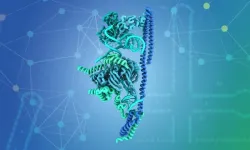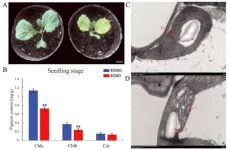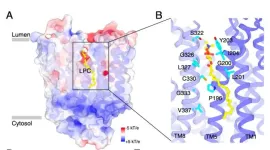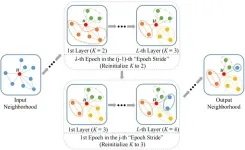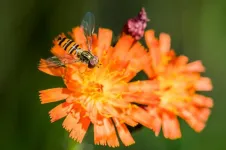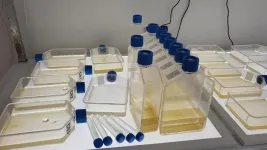(Press-News.org)
A new study has revealed the clearest-ever picture of the surface chemistry of worm species that provides groundbreaking insights into how animals interact with their environment and each other. These discoveries could pave the way for strategies to deepen our understanding of evolutionary adaptations, refine behavioural research, and ultimately overcome parasitic infections.
Scientists from the University’s School of Pharmacy used an advanced mass spectrometry imaging system to examine the nematodes Caenorhabditis elegans and Pristionchus pacificus, aiming to characterise species-specific surface chemical composition and its roles in physiology and behaviour. Their results show that nematode surfaces are predominantly oily or lipid-based, forming a complex chemical landscape. The findings have been published today in the journal JACS.
Nematodes, or worms, are found in nearly every environment on Earth, including inside animals, soil, plants, seeds, water, and even humans. Infections caused by nematodes can lead to serious health conditions in severe cases.
This research was led by Dr Veeren Chauhan, an Assistant Professor in Whole Organism Analytics at the School of Pharmacy, he explained: “Nematodes are an excellent model for human biology and are considered to be some of the most completely understood animals on the planet – especially in terms of genetics, neurology and developmental biology. We share around 60-70% of our DNA with these worms so any new discoveries about them can significantly enhance our understanding of human biology and can contribute towards solving global human health challenges.
Using world-leading mass spectrometry facilities, we studied the surface chemical properties of nematodes throughout their development. This allowed us to track molecular changes in detail and observe how surface chemistry differs during development, varies between species, and, importantly, influences their interactions with one another.”
The team used the state-of-the-art 3D-OrbiSIMS instrument at the University of Nottingham to reveal that the surface chemistry of both worm species change over time and they are made up of predominantly lipids, which account for approximately 70-80% of the molecular composition.
The University of Nottingham was one of the first institutions in the world to obtain a 3D-OrbiSIMS instrument. This instrument enables an unprecedented level of mass spectral molecular analysis across a range of materials, including hard and soft matter as well as biological cells and tissues. When the surface sensitivity, high mass resolution and spatial resolution, are combined with a depth profiling sputtering beam, the instrument becomes an extremely powerful tool for chemical analysis as demonstrated in this recent work.
Dr Chauhan continues: “Discovering that these worms have predominantly oily, or lipid-based, surface is a significant step in understanding their biology. These lipid surfaces help maintain hydration and provide a barrier against bacteria, which are essential for their survival. What is also very interesting is that these lipids also appear to serve as chemical cues that influence interspecies interactions, such as predation. For example, the predatory behaviour of Pristionchus pacificus is guided by physical contact with the surface lipids of its prey, Caenorhabditis elegans, and alterations in these lipids can increase the susceptibility of the prey to predation.”
Gaining this level of understanding of the surface chemistries of these worms and how they influence interaction and survival opens up new areas of scientific discovery and could ultimately help in developing strategies to fight parasitic worms and the diseases that they cause.”
This research was conducted in collaboration with the Lightfoot Lab, led by Dr James Lightfoot, at the Max Planck Institute for Neurobiology of Behavior – caesar in Bonn, Germany. This work was funded by a Nottingham Research Fellowship (University of Nottingham), the Engineering and Physical Sciences Research Council, the Max Planck Society, and by the German Research Foundation.
END
In human cells, only a small proportion of the information written in genes is used to produce proteins. How does the cell select this information? A large molecular machine called the spliceosome continuously separates the coding and non-coding regions of our genes – and it's doing this even as you read these lines.
The spliceosome is critical for the proper functioning of every cell, and numerous genetic disorders are linked to problems with spliceosome function. In most eukaryotic cells, two types of ...
Glaciers, sediments, and pollen can be used to reconstruct the climate of the past. Beyond ‘nature’s archive,’, other sources, such as diaries, travel notes, parish or monastery registers, and other written documents – known at the ‘society’s archive’ – contain reports and observations about local climates in bygone centuries.
In contrast, the second half of the century was characterized by heavy rainfall and floods, particularly in the 1590s.
The western parts of the European continent cooled significantly when in the 16th century a period known as the ‘Little Ice Age’ intensified. During the second ...
According to the World Health Organization (WHO), over 22% of the global population smokes, with more than 9 million smoking-related deaths reported annually. Effective treatments to alleviate nicotine withdrawal symptoms caused by smoking cessation are essential for successful smoking cessation. Currently, approved treatments for nicotine withdrawal include Bupropion and Varenicline, but there is a pressing need for new therapeutic options to improve smoking cessation success rates.
The research team led by Dr. Heh-In Im at the Center for Brain Disorders of the Korea Institute of Science and Technology (KIST) has identified a novel brain region and neural mechanism ...
EMBARGOED UNTIL WEDNESDAY, FEBRUARY 12, 2025
Mountain View, CA (Feb. 12, 2025) – According to the U.S. Physician Workforce Data Dashboard, only about 17% of cardiologists are women, ranking as one of the lowest specialties among female physicians, yet heart disease remains the number one killer of women, accounting for one in five female deaths. El Camino Health is innovating a solution to address the unique symptoms and risk factors of heart disease in women.
A new national survey conducted by El Camino Health found women (59%) are ...
A new study has uncovered a novel P-type PPR protein, BoYgl-2, which plays a crucial role in chloroplast RNA editing and chlorophyll biosynthesis in cabbage. This discovery sheds new light on the molecular mechanisms governing leaf color formation and chloroplast development, filling a significant knowledge gap in plant physiology. By identifying a spontaneous yellow-green leaf mutant and deciphering the function of BoYgl-2, the research paves the way for innovative crop breeding strategies that could enhance plant productivity and agricultural sustainability.
Leaf color is more than just an aesthetic trait—it is a vital agronomic characteristic ...
Accumulation of fat molecules is detrimental to the cell. Researchers from the Yong Loo Lin School of Medicine, National University of Singapore (NUS Medicine), have made a breakthrough in understanding how our cells manage to stay healthy by recycling important fat molecules. Their study, published in the journal Proceedings of the National Academy of Sciences (PNAS), reveals how a protein called Spinster homolog 1 (Spns1) helps transport fats out of cell compartments known as lysosomes.
Led by Associate Professor Nguyen Nam Long, from the Department of Biochemistry and Immunology Translational Research Programme (TRP) at NUS Medicine, the team found that Spns1 is like a cellular ...
Classic Graph Convolutional Networks (GCNs) often learn node representation holistically, which would ignore the distinct impacts from different neighbors when aggregating their features to update a node's representation. Disentangled GCNs have been proposed to divide each node's representation into several feature channels. However, current disentangling methods do not try to figure out how many inherent factors the model should assign to help extract the best representation of each node.
To solve the problems, a research team led by Chuliang WENG published their new ...
Male hoverflies are outflown by females when it comes to long-distance migration, new research shows.
Marmalade hoverflies leave northern Europe each autumn to escape the cold winter.
The study – by the University of Exeter – compared the number of males and females migrating at a northern point (Denmark) and further south (Spain).
At the northern point, 50% of hoverflies were male and 50% were female – but at the southern point about 90% were female, suggesting males are “poor long-distance fliers”.
“We carried out a range of tests and found females were better adapted for long-distance ...
CORVALLIS, Ore. – Certain groups of consumers appear to be open to drinking smoke-impacted wines, a finding in a new study that could provide market opportunities for winemakers increasingly dealing with the effects of wildfire smoke on grapes.
The study by researchers at Oregon State University and in New Zealand found that consumers, particularly those that like smokey flavors in food and beverages, are open to drinking smoke-impacted wines. They also found that the type of information on the label can modulate consumer acceptance.
“This ...
New research has highlighted microalgae’s capacity as a solution in the fight against climate change, but researchers warn that “smart microalgal bioprospecting” is needed to unlock its full potential.
The study highlights the vast, largely unexplored capacity of microalgae to mitigate CO2 emissions while driving sustainable industry.
“Microalgae have remarkable properties that make them an ideal tool for tackling climate change,” said lead author, PhD candidate Joan Labara Tirado from the University of Technology Sydney (UTS).
The review paper, The need for smart microalgal bioprospecting was ...

